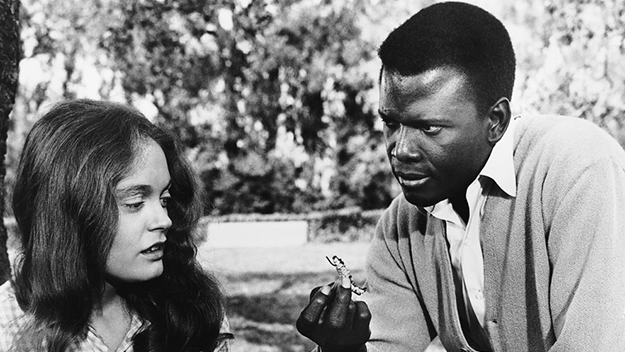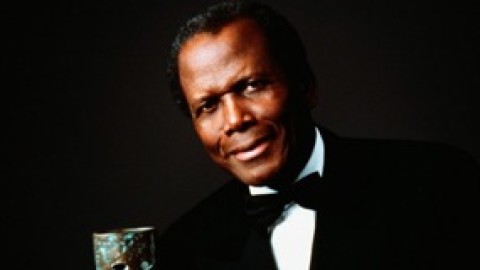TCM Diary: One Potato, Two Potato + A Patch of Blue

One Potato, Two Potato
The recent film Loving, about a mixed-race couple in 1960s Virginia and the Supreme Court case that ensured their freedom, presents a prime example of the straight-ahead message movie: unequivocal, unassailable, and unambiguous. As my colleague Michael Koresky notes in Film Comment, it belongs to a crop of 2016 movies backhandedly praised for their “old-fashioned storytelling.” Which is really to say that audiences numbed by the spectacular and synthetic soullessness of much current Hollywood product are wearily grateful for any film with its heart in the right place, even if it leaves out distinguishing details that would lend nuance to its characters and complicate its take-home lessons.
But to revisit the films actually made about interracial couples at the very time that the subjects of Loving were fighting for their rights is to challenge the term “old-fashioned.” In many of these works, we find flawed human beings instead of pristine symbols, and points of view that don’t correspond handily to ideological binaries. The practical means of navigating a multivalent world are not, in fact, black and white.
Three years before the mainstream breakthrough of Stanley Kramer’s Guess Who’s Coming to Dinner—a film which, for all its A-list talent and avalanche of good intentions, is a touchstone of respectability politics—there was One Potato, Two Potato (1964). Larry Peerce’s independently produced feature proffered a white woman and a black man whose union faces greater resistance than pseudo-progressive parents. Abandoned by her husband four years earlier and forced to raise their infant daughter alone, Julie (Barbara Barrie) stolidly endures the silent judgment afforded single mothers in mid-century, mid-size, Midwestern towns. (The unspecified Ohio burg might well have been named Hegemony.) Chatting with Frank (Bernie Hamilton) outside a movie theater, they establish that seeing films makes them feel as if they’re “living in another place, another time”—an alluring prospect to the sensitive misfit pair. As Frank walks her home, Julie confesses her love of celebrity biographies, the subjects of which (Eleanor Roosevelt, Greta Garbo) either fought for enlightenment or withdrew in its absence. Clearly, fantasy and escape are as enticing to the soul-matched couple as they are unsought by their complacent friends.

One Potato, Two Potato
Their affinity blossoms into romance, and though Frank’s parents respond with levelheaded dissent, the lovers won’t be moved. Robert Earl Jones, father of James, offers a blistering account of a proud man who can’t see how espousing self-reliance is affirming segregation. Affronts like a local cop’s suspicion that Frank is paying for Julie’s favors foreshadow the film’s pivotal (and literal) trial: when Julie’s wayward husband (Richard Mulligan) returns to find his family cohabiting with Frank’s parents and a mixed-race newborn son, he demands full custody of daughter Ellen (Marti Mericka). Observing that the girl is growing up free of prejudice in a vibrant, supportive home, the judge must weigh her comfort and contentment against a morass of narrow-mindedness in which she’s unknowingly immured.
While children are not the central figures on screen, One Potato, Two Potato is the rare film that’s attuned to their enchanted world, even deriving its title from a schoolyard game. Childhood and idealism are conflated as Frank and Julie play hopscotch on the pavement, a utopia for two, heedless of the strife their love invites. In a lucid moment, he enumerates the horrors that stand between them (“hate, riots, lynchings…”), but she counters that “kindness is enough” to overcome bigotry. At such times she’s no worldlier than Ellen, who giggles on learning she has a second father, sensing no conflict because incompatibility is a foreign notion to her. As the harmony she’s always known is threatened—not by faceless forces of malevolence but by her own father, and a legal system skewed in his favor—the phrase “suffer the little children” takes on a tragic prescience. The framing device of the court hearing, however schematic (including silly, superfluous voiceover from the judge), yields a closing shot that shames every paean to peace, love, and understanding perpetrated by Hollywood’s limousine liberals: the heartbreaking conclusion reveals how outmatched basic kindness is in a world whose governing force is inertia.
“Love is color blind” was the tagline for Guy Green’s A Patch of Blue (1965), but that’s the only bromide attached to a film that eschews facile sentiment. The far superior mid-’60s interracial love story staring Sidney Poitier (in large part because he’s not being judged for suitability), A Patch of Blue traces the burgeoning affection of Selina (Elizabeth Hartman), a blind girl from a deeply dysfunctional home, and Gordon (Poitier), a realistic but compassionate office worker. Meeting in the park where she finds refuge from her abusive prostitute mother (Shelley Winters) and drunken grandfather (Wallace Ford), Selina and Gordon bond over simple acts of kindness. As their rendezvous become daily oases in their troubled lives, Selina develops romantic feelings for Gordon, whom she doesn’t realize is black—and whose assessment of their potential as a couple is less sanguine.

A Patch of Blue
The premise—drawn from Elizabeth Kata’s novel Be Ready with Bells and Drums, discovered by Green’s wife—presents two problematic factors at the outset. The first is whether it can truly qualify as an interracial romance if one party resists the advances of another, and the racial disparity is known only on one side. While it may not be a love story in the traditional sense, there’s more trust and tenderness on display here than is found in most cinematic treatments of amour fou—culminating in a kiss both ingenuous and passionate. And as gracefully scripted by Green, from his own outsider vantage as a British cinematographer-turned-transatlantic filmmaker (manifested in the film’s drab kitchen sink-realist aesthetic), the racial aspect is ever-present. The glares they draw in the park are sharply felt by Gordon, who spares Selina the knowledge of further disdain, and learning of his race from her mother only seems to solidify her feelings of connection.
That leads to the larger concern: does Selina’s blindness (like Julie’s single motherhood in One Potato, or Patty Duke’s extramarital pregnancy in the milestone TV movie My Sweet Charlie) reduce her intrinsic worth—making her, in her diminished state, an appropriate love interest for a black man? Green curtails this possibility by making Selina’s family, not her handicap, the source of her grief. While the screenplay attends to the world of a blind person with uncommon insight and intelligence (her anxiety over finding a restroom in strange surroundings, her alertness to the sound of screeching tires before crossing the street), it never paints her as a victim due to her sightlessness, nor as a less-than-ideal partner. Her toxic domestic life is the thing holding her back, as his protective inhibitions keep him at a remove from all those close to him. Their union, such as it is, offers not redemption or hope for society but deliverance from their lonely, circumscribed lives.
Gordon does indeed seem estranged from the black community, as his only interactions with another person of color are with his brother Mark (Ivan Dixon), a doctor whose avowed views presage those of the Black Panther Party. “Let whitey educate himself!” he rails at Gordon’s efforts to improve the lot of Selina, who Mark believes “comes from a trash heap.” “Maybe so, but she’s not trash,” retorts Gordon, stoking what is doubtless a long-standing argument, Mark’s rigid militancy refuting his brother’s pragmatic humanism.

A Patch of Blue
In a recent conversation, Green’s daughter Marilyn Feldman told me that Poitier and Dixon were “unhappy with the dialogue in their scenes together, and offered to modify it to represent more accurately the way black people talk.” As a result, the scene feels authentically lived-in, and charged with a clash of viewpoints both actors knew well. Feldman also related that Poitier commissioned changes to the novel’s third act, presumably to leave the couple’s future open-ended.
Early in the film, Gordon claims his favorite word is “tolerance,” but denies that it’s his defining trait. Tolerance, the delicately devastating ending suggests, is like the patch of blue sky recalled by Selina in a hopeful reverie. It’s a faint and fleeting thing, but it’s the light in a dark world.
One Potato, Two Potato and A Patch of Blue air January 16 on Turner Classic Movies.
Steven Mears received his MA in film from Columbia University, where he wrote a thesis on depictions of old age in American cinema.







